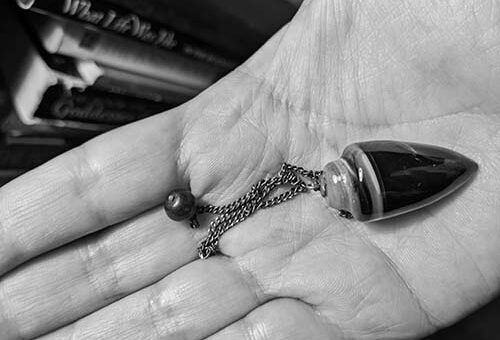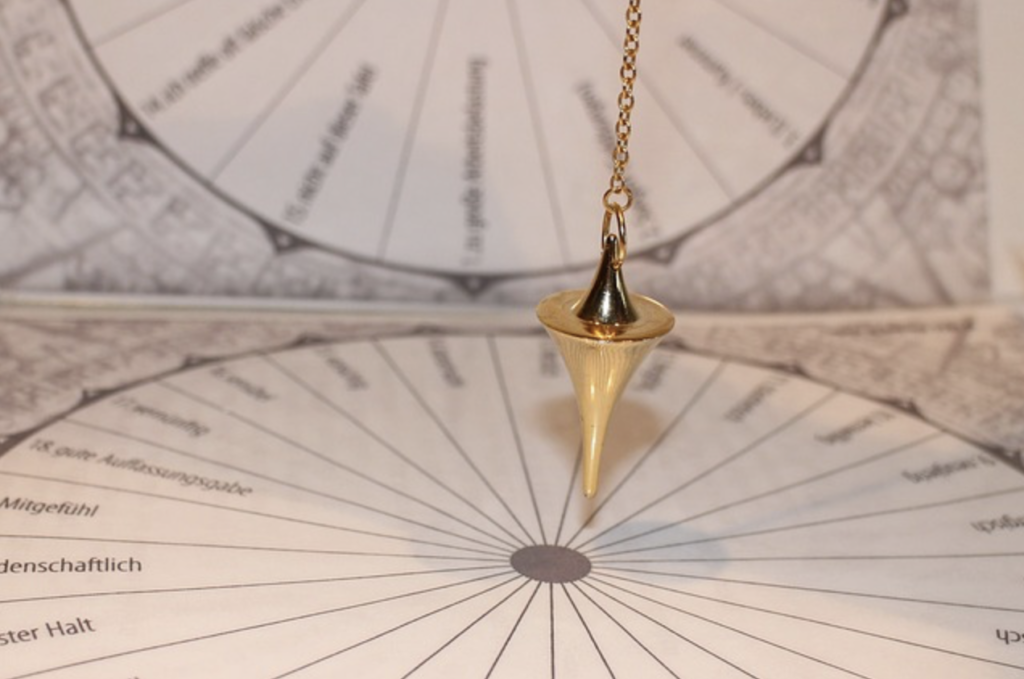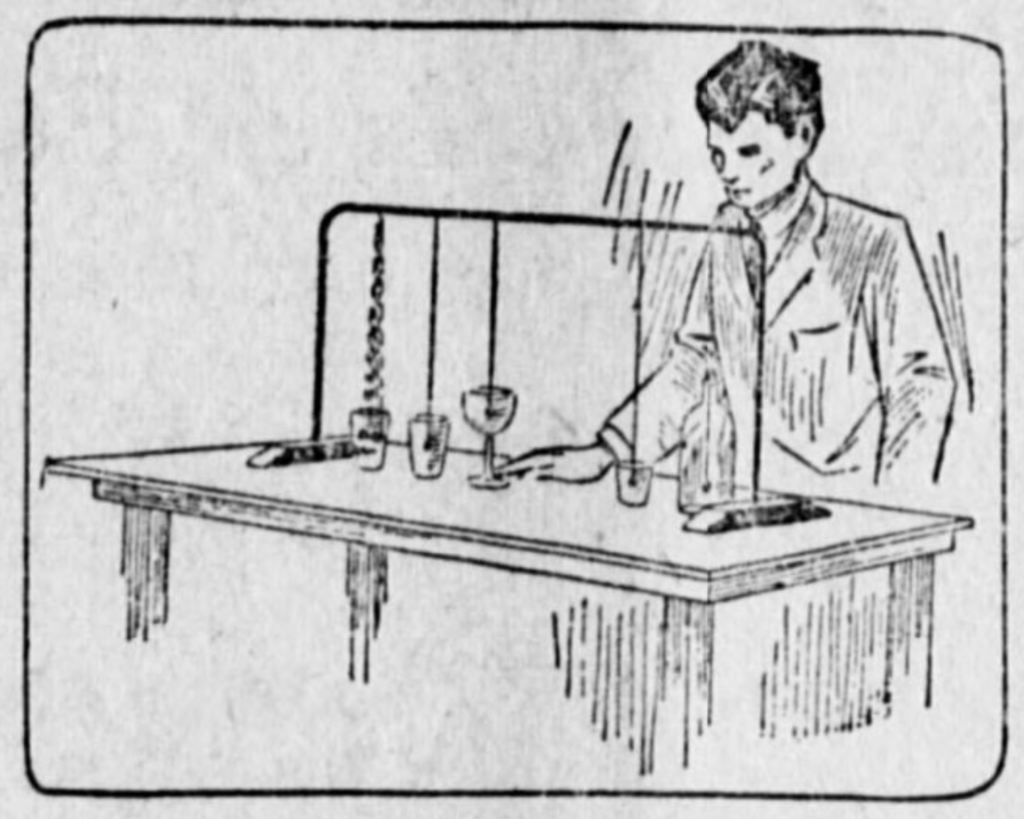
Of all the tools used for divination and dowsing, pendulums may be possibly one of the simplest to learn how to use.
But what exactly is divination?
Divination is the practice of foretelling the future or revealing hidden knowledge through particular objects or rituals. This could include tarot readings, astrology, or even I Ching.
People have been using divination techniques for centuries to gain insight into their lives and the future. While the practice is often seen as controversial, many people swear by its accuracy.
Using a Pendulum for Divination
To use a pendulum for divination, you must first clear your mind and focus on your question.
Then, hold the pendulum about 6-8 inches above the surface of a table and ask a question.
Watch the pendulum to see how it moves. For example, the pendulum may swing back and forth, move in a circle, or move in a straight line.
The type of movement may indicate the answer to your question. For example, if the pendulum swings back and forth, the answer is yes. If the pendulum moves in a circle, the answer is no. If the pendulum moves in a straight line, the answer is maybe.

Pendulum Dowsing Tips
Dowsing is a centuries-old practice that uses a tool to locate objects or materials. The tool, most commonly a pendulum, is thought to be moved by the divine or other unseen force that leads the dowser to the desired object.
There are many ways to use a pendulum for dowsing, but here are a few tips to get you started:
- Choose the correct pendulum. Not all pendulums are created equal. Some pendulums are better for finding objects, while others are better for finding water or minerals. Choose the type of pendulum that fits your needs.
- Find a quiet place to dowse. Dowsing is a personal experience, and it’s essential to have a calm space where you can focus.
- Clear your mind. The key to successful dowsing is to clear your mind of all distractions and focus on your question.
- Ask a straightforward question. The more specific your question, the better. “Where is the object?” is much better than “Is the object nearby?”
- Hold the pendulum still. Hold the pendulum still and ask your question when you’re ready to dowse. Wait for the pendulum to move before interpreting the answer.
- Be patient. Dowsing takes practice, so be patient and keep practicing. You’ll soon start to see results.
How to Make a Basic Stationary Pendulum
A pendulum is a weight suspended from a pivot to swing freely.

To make a pendulum, you will need:
A weight
A pivot
A string or a wire
The weight can be anything that has mass. The pivot can be a nail, a screw, or a bolt. The string or wire can be anything that is strong and can hold the weight.
Herbal Pendulum
In Magical Herbalism (Scott Cunningham) we learn of herbal pendulums.
Cunningham tells us to choose an herb, such as a star anise seed or orris root, and tie a natural fiber string around it. Or, if possible, drill a hole into the herb seed or dried root and put the string through that.
Herbal pendulums can be used the same way as a crystal pendulum.
How to Cleanse and Charge a Pendulum
To cleanse and charge a pendulum, first cleanse it by smudging it with sage, palo santo, or another cleansing herb. You can also cleanse the pendulum with sunlight or moonlight.
Note: Donald Tyson (Scrying for Beginners) strongly advises against letting the sun shine on a pendulum. He writes:
“Never allow the scrying pendulum or any other tool associated with it to lie exposed to direct sunlight. The Sun will neutralize the occult virtue of the Moon that is in your crystal pendant naturally…”
As both a sun and moon lover, I feel that the sun and/or the moon can be used in cleansing or charging a crystal. It all depends on your personal beliefs and what type of energies you work with.
Next, charge the pendulum with your energy. Hold the pendulum in your hand and focus on your intention for the pendulum. Visualize the energy of your intention flowing into the pendulum. You can also recite a mantra or prayer while you charge the pendulum.
Once the pendulum is cleansed and charged, it is ready to use. Hold the pendulum in your dominant hand and ask it a question. The pendulum will swing in a particular direction to answer yes or no. You can also ask the pendulum to give you guidance on a particular issue.
Pendulum Charts
A pendulum chart is created by drawing a circle and dividing it into 12 equal segments. Inside the circle, you draw an equal-armed cross, with the center of the cross as the point where the pendulum hangs. You then ask a question, and the pendulum will swing in one of the 12 segments, indicating an answer.
The 12 segments correspond to the following:
1- Upper right: The present
2- Upper left: The recent past
3- Right: The near future
4- Center: Now
5- Left: The recent past
6- Lower left: The distant past
7- Lower right: The future
8- Opposite of the question
9- Past
10- Present
11- Future
12- undecided or doesn’t answer
The interpretation of a pendulum chart depends on the question you ask, and the individual segments will mean different things depending on the situation. However, some general things to look for include:
- The direction the pendulum swings: Clockwise or counterclockwise?
- The speed of the swing: Fast or slow?
- The distance the pendulum swings: Wide or narrow?
All of these factors can give you clues about the answer to your question. For example, if the pendulum swings quickly and to the right, it might mean that the answer is affirmative or positive. If it swings slowly and to the left, it might mean that the answer is negative or no.
Pendulum charts can be a great way to get a quick and easy reading on a situation and can provide valuable insight into the answer to your question.

